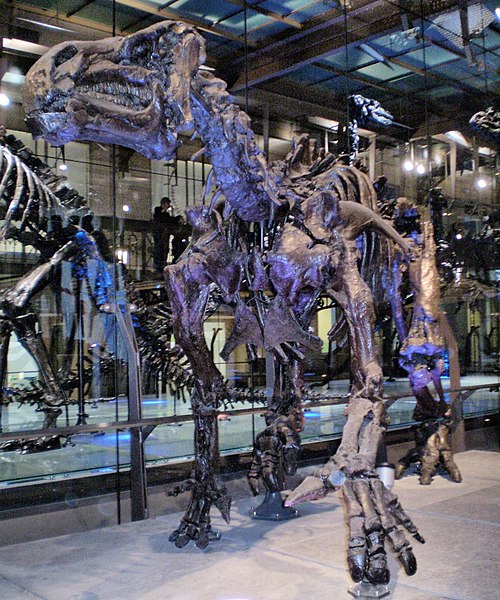Facts for Kids
Iguanodon was a large herbivorous dinosaur known for its unique thumb spikes and versatile locomotion.
Overview
Fossil Evidence
Social Behavior
Discovery And Naming
Habitat And Distribution
Physical Characteristics
Diet And Feeding Behavior
Evolutionary Significance
Iguanodon In Popular Culture

Inside this Article
Megalosaurus
Combination
Skeleton
Portugal
Dinosaur
Fossil
Thumb
Love
Neck
Did you know?
🦖 Iguadon was one of the first dinosaurs to be named, with its discovery occurring in 1825.
🌿 As a herbivore, Iguadon primarily fed on plants, using its impressive beak to trim leaves and stems.
🏞️ Iguadon lived during the Late Jurassic period, approximately 160-120 million years ago.
🦷 It possessed large thumb spikes, which may have been used for defense against predators.
🚶 Iguadon could walk both on two legs and four legs, showcasing its adaptability.
🌍 Fossils of Iguadon have been found in Europe and North America, indicating its wide range.
⚖️ Adult Iguadon could grow up to 33 feet long, making it one of the larger dinosaurs of its time.
🔍 The first Iguadon skeleton was discovered in a quarry in England, leading to significant paleontological advancements.
🦙 Iguadon is believed to have lived in herds, providing safety in numbers against predators.
📸 The distinctive shape of Iguadon has made it a popular subject in art and media regarding dinosaurs.
Introduction
It was one of the first dinosaurs to be named and studied. The name "Iguanodon" means "iguana tooth" because its teeth were similar to those of modern iguanas. Iguanodon was a large herbivore, which means it only ate plants. 🌿
These dinosaurs could grow to be about 30 feet long! That’s as long as a school bus! Iguanodon is famous for its unique thumb spikes, which it used for defense against predators like the mighty Megalosaurus.
Fossil Evidence
Many Iguanodon fossils have been found, including teeth, bones, and footprints! Some of the most famous fossils were discovered in the 19th century in England and Belgium. Paleontologists carefully studied these fossils to learn how Iguanodon lived. One remarkable find is a nearly complete Iguanodon skeleton at the Natural History Museum in London. 🏛
️ These fossils tell us about their size, how they walked, and even how they might have behaved with each other!
Social Behavior
Researchers believe these dinosaurs traveled in herds to stay safe from predators. By being in groups, they could warn each other about danger and help protect the young ones. 🐣
They may have also communicated through sounds or body language. Imagine them chatting while munching on snacks! The social behavior of Iguanodon is still a mystery, but clues from fossils suggest that they enjoyed the company of others while exploring their environment.
Discovery And Naming
🔬 He found some amazing teeth in a quarry in Sussex, England. Mantell noticed that these teeth looked a lot like those of iguanas, which is how the dinosaur got its name! He described Iguanodon in a scientific paper, and it was one of the first dinosaurs to be named. 🦕
More bones were found in later years, helping scientists learn more about Iguanodon, including how it walked on two legs and sometimes four!
Habitat And Distribution
Fossils have been found in Europe, especially in Belgium and England, showing that Iguanodon thrived in these regions. During the Early Cretaceous, the climate was warmer and wetter, perfect for lush plant life. 🌞
Iguanodon liked to munch on ferns and cycads, which were common in its habitat. Some rocks in these areas also show that Iguanodon roamed in places that are now part of Spain and Portugal!
Physical Characteristics
It was a big dinosaur, measuring up to 30 feet long and weighing over 4 tons! Its most interesting characteristic was its thumbs! Each hand had a thumb spike that could be used to defend itself against hungry predators. 🦖
Iguanodon also had leaf-shaped teeth that were perfect for munching on plants and ferns. It walked on two strong legs most of the time, but it could use all four legs when eating or traveling slowly. This combination made Iguanodon a unique and adaptable dinosaur!
Diet And Feeding Behavior
It had flat, grinding teeth made to chew tough leaves, ferns, and other plants. Iguanodon could reach high to nibble on trees thanks to its long neck. It also used its strong jaws to tear down branches! 🦷
Iguanodon was a selective eater, preferring fresh and nutritious plants, much like us enjoying yummy salads! 🌱
When searching for food, Iguanodon likely traveled in groups, making it easier to find and share tasty meals.
Evolutionary Significance
It belonged to a group called Ornithopoda, which includes many dinosaur relatives. Its unique thumb spikes help scientists understand how dinosaurs evolved for survival. Iguanodon is also significant because it was one of the first dinosaurs studied, helping researchers in the 19th century understand what dinosaurs were! 🧑
🔬 This paved the way for discovering even more dinosaur species and understanding how they lived millions of years ago.
Iguanodon In Popular Culture
In the animated film "We're Back! A Dinosaur's Story," Iguanodon is one of the main characters. Kids love to learn about dinosaurs, and Iguanodon is often featured in dinosaur books and educational programs. 📚
Iguanodon toys and models are also popular, allowing young dino fans to imagine what it's like to explore the world with this incredible creature! Kids can discover everything about Iguanodon and join the adventures of these amazing dinosaurs!

